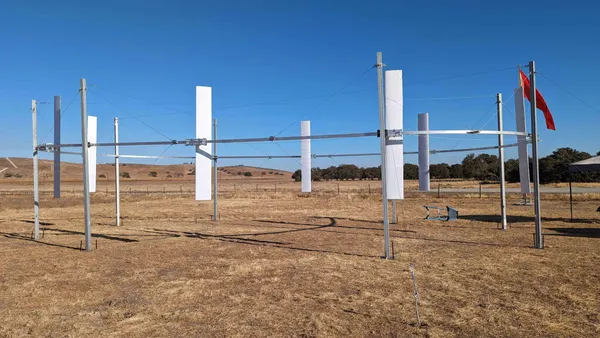The following is a contributed article by Steven Shparber, a member in the Washington, D.C., office of Clark Hill PLC, and Michael Borgatti, vice president of RTO Services at Gabel Associates in Philadelphia, Pennsylvania. The opinions expressed herein are solely those of Mr. Shparber and Mr. Borgatti. They should not be attributed to any of their clients, including the American Clean Power Association and Solar Energy Industries Association.
It is no secret that the energy industry is rapidly transforming to a much more decentralized model that relies more directly on renewable and storage technologies (sometimes referred to as "Variable Energy Resources" or "VERs") to keep the lights on. As part of that transformation, consumers and states are increasingly choosing specific sources of clean energy, such as offshore wind, solar and energy storage. Industry and political pundits alike expect these trends to continue and even potentially accelerate — and a key question is whether electricity markets will keep pace.
With Commissioner Richard Glick's appointment as Chairman of the Federal Energy Regulatory Commission (FERC), and his focus on making "significant progress on the transition to a clean energy future," there are growing expectations that FERC may restructure the PJM Interconnection's controversial minimum offer price rule (MOPR), and similar constructs in the New England Independent System Operator (ISO-NE) and the New York ISO (NYISO).
In December 2019, FERC instructed PJM to greatly expand its longstanding MOPR construct to now mitigate capacity offers from any resource that is eligible for essentially any financial incentive that is offered by a state or other local government entity, including Renewable Energy Credits (RECs). Chairman Glick dissented on this order, as well as subsequent orders regarding state policy mitigation in PJM, NYISO and ISO-NE, and under his leadership, FERC is likely to take a new direction on capacity markets.
Some see MOPR as necessary to protect capacity markets against anticompetitive subsidies. Others see it as a regulatory overreach that prevents states from choosing energy sources that satisfy their economic and policy interests. Regardless of where along this spectrum individual views land, a near-consensus is emerging that expansive mitigation will not lead to durable solutions. Many stakeholders are therefore beginning to ask whether (and how) the RTOs must fundamentally reimagine centralized capacity markets if they are to remain relevant.
To that end, in November 2020, the American Wind Energy Association (which merged into the American Clean Power Association in January 2021) published a whitepaper outlining a new capacity market design construct, entitled "Capacity as a Commodity" (CAAC). This article provides an overview of the CAAC construct and describes why it should be seriously considered as an alternative capacity market design, particularly in proceedings such as PJM's recently announced stakeholder process exploring enhancements to its capacity market.
Current challenges
At a high level, today's capacity product is essentially a call option that an RTO holds for a generator's output when needed to satisfy future demand. These markets procure capacity as if all capacity is "one-size fits all," failing to distinguish between capacity from different resource types.
This model makes sense in an environment where large, centralized generators are the dominant sources of capacity. However, all suppliers are not created equal in an environment dominated by VERs — and interconnection queues clearly show that VERs will be the bulk of new resources on the grid moving forward. The markets need a mechanism that quantifies grid services and provides transparent price signals to resources with the most significant contribution to reliability.
Similarly, today's capacity market prices do not efficiently reflect willingness to pay for capacity from different sources. Public policies like renewable portfolio standards and corporate green energy procurement goals that are becoming increasingly common across the Fortune 500 Companies are both forms of consumer choice. Valuing reliability and consumer choice through market prices represents the foundation of a durable capacity construct for investors, consumers and policymakers alike.
A potential solution: Capacity as a commodity
The CAAC market design concept attempts to address these two, sometimes competing, interests through a centralized capacity construct that combines attributes of conventional commodity exchanges and REC tracking platforms.
First, a forward bilateral exchange would provide transparent market prices (via the direct purchase and sale of "Capacity Credits") that reflect buyers' willingness to pay for capacity from different types of resources, and procurement decisions and market prices could reflect energy policy choices made by states and voluntary clean energy objectives. Buyers would have the option, but not the obligation, to bid for all or a portion of their forecasted capacity obligation from any resource. As bilateral transactions close, the exchange would post index pricing updates that provide a transparent forward price signal to all market participants.
Like conventional commodity markets, this platform would provide market participants and onlookers with essential information like trading volumes, open positions, and bid/ask spreads. This structure would allow buyers and sellers to calibrate their strategies during the bilateral window in response to market signals and changing fundamentals like load forecasts. It also would allow the market to reflect the impact of evolving state and federal energy policies in real-time.
The framework also maintains a crucial role for the RTO in administering centralized "backstop" centralized auctions (the Residual Reliability Auction or RRA) that ensures local and regional reliability. These RRAs would allow the RTO to procure capacity to provide any missing reliability services after taking into account all bilateral trades of capacity that occurred between buyers and sellers during the bilateral window that precedes the RRA for a given Delivery Year. The RRA would ensure that regional reliability is maintained as it is today and would provide a transparent price signal reflecting the region's reliability needs.
Importantly, under this construct, any market power mitigation would be limited to targeting acute market power concerns, such as affiliate transaction abuse, vertical and horizontal market power, and direct out-of-market payments to specific suppliers or at predetermined prices. The receipt of generally available out-of-market payments would not cause the need for any market power mitigation measures such as the MOPR.
Conclusion
While numerous details related to CAAC would need to be discussed by all stakeholders before it is conceivably implemented in any RTO, CAAC represents a straightforward market design that is understandable, implementable, and durable. RTOs should seriously consider CAAC as a viable alternative to today's centralized capacity market designs, as it would help to meet the clean energy goals of state and local policymakers and customers, send clear price signals to market participants, enhance competition and provide more options to consumers, and maintain overall system reliability.













